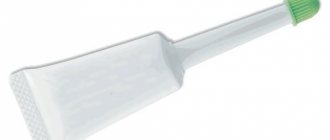Author, editor and medical expert - Klimovich Elina Valerievna.
Number of views: 459 348
Last updated date: 11/16/2021
Average reading time: 17 minutes
- Therapeutic diet
Constipation (from the Latin constipatio - accumulation, accumulation) can occur in a child at any age1, 3. It is associated with a slowdown in the movement of feces through the intestines3, 4. This is one of the most common “children’s” problems4, but many parents do not recognize it or They believe that a child at 3 or 4 years old will “go away on its own”, without medical help. Some parents do not consult a doctor on time3, 5 because they cannot understand whether the baby goes to the toilet often enough, whether the density and volume of feces is normal1, 3, 5.
Up to contents
Types of constipation
Depending on the duration and severity, children are distinguished between chronic and acute constipation. Acute constipation is said to occur when there is no bowel movement for several days in a row.
According to the stages and causes of defecation delay, they are divided into several types:
- Primary – a consequence of congenital or acquired pathology, disruption of innervation or abnormalities in the structure of the intestine. Even a one-month-old baby can experience such constipation;
- Secondary - occurs due to injury, illness, or as a side effect of any medication.
- Idiopathic - a consequence of impaired intestinal motility for unknown reasons.
According to pathogenesis, the following varieties are distinguished:
- Nutritional – a consequence of a lack of fluid in the body, dietary fiber and a decrease in food intake in general;
- Mechanical - arise due to a narrowing of the intestinal lumen;
- Dyskinetic - a consequence of disturbances in the functioning of the digestive organs and intestinal innervation.
According to the clinical picture, functional constipation in children is divided based on the tone of the intestinal walls:
- Atonic (with reduced tone). Peristalsis is sluggish, the movement of feces is slow, which is why defecation is delayed.
- Spastic - occur against the background of heaviness, bloating, flatulence, intestinal colic. A small amount of feces comes out. Constant spastic constipation occurs in a child due to intestinal spasms, due to which feces accumulate and move with difficulty.
Symptoms
A child after 2 years of age can tell or show 3, 4 parents that he cannot go to the toilet or is in pain. But recognizing constipation in an infant aged 1.5 - 2 years is not so easy3, 4, 5.
In the case of infants, doctors recommend focusing not on the frequency of stool, which varies greatly among infants3,4, but on the density of feces and the baby’s behavior during bowel movements1,4.
If he does not cry during bowel movements, the feces pass softly, have a characteristic appearance and color1, 4, and the tummy does not become dense, as if inflated, then it is considered that the baby does not have constipation, even if he soils his diaper 2 times a week1, 4.
You can talk about probable constipation in a baby if the stool becomes denser, thicker, darker than usual 1, 4. Children under one year of age often have a swollen tummy, when pressing on it they cry or whine, and at the moment of stool expulsion they can tense up and scream 14.
After a year and older, the following are considered signs of insufficient bowel movements:
- The child began to go to the toilet “mostly” less often than before1, 3, 4.
- During defecation, it is clear that he is in pain, he has to strain 1, 3, 4.
- Passing less stool than usual1, 3, 4.
- How does it look dry, hard, dense1, 3, 4.
If the child has already had stool retention before, and he remembers5 that it hurts, then he begins to bring his legs and knees together, walk on his heels, tuck his buttocks, hold his breath for a short time - wait it out and suppress the urge. During defecation, it is clear that the process is difficult, and to facilitate it one has to take different positions3, make significant efforts, push2, actively work with the anterior abdominal wall1, 4.
If a child has one or more signs of constipation 2-3 times within 2 months1, 6, then you need to monitor the nature and frequency of stool, and if suspicions are confirmed, then consult a doctor to find a way to help your child with constipation, select a diet and treatment1, 3.
The table below provides information 4 about approximately how many times children of different ages can have bowel movements, as well as the characteristics of stool.
| Age | How many times a day do you have stool? | Color and consistency of stool |
| 0-3 months, breastfeeding | From 1 to 5-6 times, sometimes up to 1 time every 4-7 days | Viscous, similar to semi-liquid porridge. Color - yellow, yellowish-green, golden yellow, usually uniform or with white lumps. |
| 0-3 months, artificial feeding | 1 to 4 times | Pasty. Color ranges from yellow to light brown. |
| 6-12 months | 1-3 times | Soft, shaped or pasty, brown, light brown or dark yellow, brownish-greenish. |
| 1-3 years | 1-2 times | Decorated, brown. |
| Over 3 years old | 1 time a day or at least 3 times a week | Decorated, brown, dark brown. |
Up to contents
Causes of constipation in children
In young years
In a child under one year of age, the causes of constipation may lie in:
- genetic predisposition;
- poor nutrition of a nursing woman;
- insufficient drinking regime;
- muscle hypotension;
- rickets;
- perinatal encephalopathy;
- intestinal dysbiosis;
- intolerance to cow's milk protein;
- iron deficiency;
- sudden transition to artificial feeding;
- feeding children with high-iron formula;
- sudden transition from one mixture to another;
- hypothyroidism. Source: O.N. Komarova, A.I. Khavkin Constipation in young children: causes and features of dietary correction // Issues of modern pediatrics, 2014, No. 13 (1), p. 114-118
In older age
In children older than one year, the cause of constipation may be:
- uncomfortable and unsanitary conditions of toilets in a kindergarten or school (psychogenic constipation); Source: M.I. Dubrovskaya, P.V. Parshina Current issues in the development of constipation in children, approaches to therapy // Issues of modern pediatrics, 2012, v. 11, no. 11, pp. 76-82
- anusitis (inflammation of the skin and mucous membrane of the anal canal from the proximal areas of the skin folds around the anus to the dentate line and the blinker valves, i.e., the sphincter zone);
- improper diet, unbalanced diet;
- taking medications that cause fecal retention as a side effect;
- dehydration – dry food, excess dietary fiber in the diet, condition after diarrhea, vomiting, excessive sweating;
- deliberate delay in defecation for mixed reasons, which leads to compaction and drying of stool in the intestine.
Diagnostics
A pediatrician examines children who retain stool. If necessary, a pediatric gastroenterologist is involved in consultation. The specialist collects a detailed medical history and identifies predisposing factors, dietary changes, and concomitant diseases. To verify the cause of constipation, an instrumental examination of the gastrointestinal tract and laboratory methods are prescribed. The most informative:
- Finger examination
. Assessing the condition of the rectal ampulla is the first thing to do when a child is constipated. During the examination, fecal stones, large neoplasms, and places of greatest pain are determined. Before the examination, the abdomen is palpated to detect bloating, spasms, and an increase in the size of the sigmoid colon. - Ultrasonography
. Ultrasound of the abdominal cavity is a simple non-invasive diagnostic method that shows signs of inflammatory processes, abnormalities in the structure of the digestive tract, and suspicious neoplasms. Additionally, using an ultrasound sensor, a targeted ultrasound of the liver and pancreas is performed. - Radiography
. A survey X-ray of the abdominal cavity is quite informative and allows one to detect dilation of intestinal loops and signs of intestinal obstruction. To check the condition of the colon, barium irrigography is prescribed, which is performed after an enema. Sometimes radiography of barium passage through the gastrointestinal tract is used. - Coprogram
. Microscopic examination of stool includes determination of undigested food particles, fatty acids, red blood cells and white blood cells. Bacteriological culture of stool is required to exclude dysbacteriosis. The stool is examined for helminth eggs and the presence of protozoal infections. - Laboratory indicators
. If a child has persistent constipation, a biochemical blood test and liver tests are performed to rule out concomitant hepatobiliary disorders. If endocrine diseases are suspected, the hormonal profile is examined. Sometimes a highly specialized toxicology blood test is indicated. - Additional methods
. To exclude organic pathology and intestinal tumors, sigmoidoscopy or colonoscopy is recommended. To diagnose Hirschsprung's disease and UC, a biopsy of the intestinal wall is taken during the study. If there are signs of nervous system disorders, you need to consult a neurologist, EEG and EchoEG.
What to do if a child has constipation - treatment methods for children of all ages
How to treat a child depends on the severity and type of problem. These could be medications, enemas, massage, diet.
It is not recommended to do enemas frequently, otherwise flaccid bowel syndrome may develop. That is, he will “forget how” to work independently. However, sometimes enemas are useful. Their volumes vary by age:
- up to 1 month – 30 ml;
- 1-3 months – 30-40 ml;
- 3-6 months – 90 ml;
- 6-12 months – up to 180 ml.
The temperature of the water in the enema should be around 23-24℃.
Massage helps well with atonic constipation. You need to massage the anterior abdominal wall in a clockwise circular motion. It is useful to place a small child on his stomach and gently irritate the anus with your hand.
To improve peristalsis, you can give a glass of juice or water.
For psychogenic constipation, you need to follow a number of recommendations:
- give more vegetables and liquids;
- do not focus on the problem, support the child;
- play role-playing games, behave positively, do not show frustration;
- do not scold the child, tell him how his body works, help him understand the problem;
- tell thematic tales, you can invent them yourself.
What can you give your child for constipation? Overview of drug groups
For spastic constipation, suppositories with glycerin can help. The introduction of other substances, including oils, is not recommended.
For constipation, several groups of laxatives are indicated:
- osmotic - transfer liquid to the stool to soften it, safe for children, they can be taken every day and for a long time - magnesium hydroxide, polyethylene glycol, lactulose, magnesium citrate, sorbitol;
- stimulants - promote contraction of the intestinal muscles, move stool through it, they are prescribed for a single dose - bisacodyl, senna;
- lubricants - facilitate the process of stool movement through the intestines, have an oil base - glycerin suppositories, petroleum jelly.
Diet
Nutrition should be correct, with plenty of liquid and plant fiber - vegetables, fruits, oatmeal, pearl barley, etc. You need to give up foods that slow down motor skills, control the caloric intake of the diet, the content of minerals and vitamins in it. The following products are excluded from the menu, and if the child is breastfed, they are excluded by the nursing mother:
- milk;
- strong tea, coffee;
- semolina;
- fatty food;
- baking;
- pasta;
- White bread;
- crackers;
- rice.
It is important to increase fiber in the diet, which will regulate bowel movements. It is abundant in fruits, vegetables, legumes, whole grains, seeds and nuts. The listed products are rich in minerals and vitamins and contain a lot of protein. The fiber content should be 2 g per serving. Recommended standards by age:
- 1-3 years – 19 g per day;
- 4-8 years – 25 g per day;
- 9-13 years - 31 g per day for boys, 26 g per day for girls.
Foods high in fiber
| Product | Fiber content |
| White beans | 9.5 g per ½ cup |
| Cereals | 8.8 g per ½ cup |
| Red beans | 8.2 g per ½ cup |
| Legumes | 7.5 g per ½ cup |
| Pear with peel | 4.3 g per small fruit |
| Raspberries | 4 g per ½ cup |
| Country style potatoes | 3.8 g per 1 piece. |
| Almond | 3.3 g per 30 g |
| Apple with peel | 3.3 g per 1 piece. |
| Banana | 3.1 g per 1 piece. |
| Orange | 3.1 g per 1 piece. |
| Broccoli | 2.8 g per ½ cup |
| Green pea | 2.5 g per ½ cup |
| Corn | 1.6 g per ½ cup |
| Strawberry | 1.5 g per ½ cup |
| Wild rice | 1.5 g per ½ cup |
| Raisin | 1.4 g per ½ cup |
Changing mode
The child needs to be taught to have bowel movements at the same time every day. To stimulate bowel movements, you can give cold water or fruit juice.
Regular physical activity is necessary to improve the functioning of the abdominal muscles. This could be regular walks, ball games, jumping rope, swimming, cycling.
Mother's diet
Source: Alexander Dummer: Pexels
Breastfeeding mothers often wonder how their diet affects the quality of their breast milk and how choosing foods for it can affect the baby's digestive system. However, most women do not need to restrict their diet while breastfeeding and should aim for a nutritious and varied diet.
In some cases, infants may seem to avoid feeding after the mother has taken certain foods. In this case, a woman can simply eliminate this food from her diet and return to it after stopping breastfeeding.
Important: Special recommendations include avoiding caffeine while breastfeeding. Caffeine is easily transmitted to the baby through milk. It reduces the amount of iron in milk, which can lead to iron deficiency anemia. It is recommended that a nursing mother consume no more than 400 milligrams of caffeine per day. The most caffeine is found in coffee and chocolate, and the least in tea.
A healthy diet while breastfeeding is essentially the same as a nutritious diet without breastfeeding. The main difference is that breastfeeding people need 450 to 500 extra calories per day. But if you want to lose weight after pregnancy, you can do without them, having first discussed this with your doctor.
A healthy diet for a pregnant woman includes:
- Fruits, especially rich in potassium and vitamin A (melon, banana, apricot, mango, oranges). Helps reduce the risk of constipation in both the child and the mother;
- Vegetables containing vitamin A and potassium (spinach, carrots, tomatoes, red peppers);
- Grain products, especially brown rice and whole grain bread;
- Protein-containing foods such as beans, peas, nuts, meat, fish, mussels.
Important: A nursing mother needs to drink a lot of water, especially in the first weeks after birth. Lack of fluid negatively affects milk production. A sufficient amount of water ensures the efficient functioning of the digestive system, helps food to be absorbed, which means breast milk will be well-balanced in nutrients. The higher the conditional quality of milk, the lower the likelihood of constipation in a child, since balanced milk improves peristalsis and fecal removal.
Preventive measures
The diet should contain a lot of vegetables, fruits, cereals and wholemeal flour; you can add wheat and oat bran as sources of fiber. It is better to cook vegetable soups. The child should drink a normal amount of liquid - fruit drinks, compotes, clean water, juices.
One of the most important conditions for normal bowel function is constant moderate physical activity. Any kind of sports or even just regular walks will be very useful.
You need to teach your child how to sit on the toilet correctly. Your feet are on the floor, your knees are bent, you can even raise your knees a little by placing a small bench under your feet, your torso is tilted forward. There is no need to push; on the contrary, you need to relax so that the intestines themselves perform the act of defecation.
Sources:
- P.L. Shcherbakov, L.N. Tsvetkova, V.V. Kashnikov. Chronic constipation in children // Issues of modern pediatrics, 2005, vol. 4, no. 4, pp. 54-62.
- HE. Komarova, A.I. Khavkin. Constipation in young children: causes and features of dietary correction // Issues of modern pediatrics, 2014, No. 13 (1), p. 114-118.
- M.I. Dubrovskaya, P.V. Parshina. Current issues in the development of constipation in children, approaches to therapy // Issues of modern pediatrics, 2012, vol. 11, no. 11, pp. 76-82.
Vostrikova Ekaterina Borisovna Clinic
Author of the article
Vostrikova Ekaterina Borisovna
Specialty: gastroenterologist
Experience: 13 years
The information in this article is provided for reference purposes and does not replace advice from a qualified professional. Don't self-medicate! At the first signs of illness, you should consult a doctor.
Traditional methods of treatment
In addition to standard treatments, there are alternative ways to combat constipation.
Abdominal massage
In addition to relieving symptoms and treating constipation, abdominal massage has a strengthening effect on the abdominal muscles and relieves pain from infant colic.
Source: oksun70 / Depositphotos
The essence of the massage is light and gentle stroking of the child’s abdomen, smoothly transitioning to pinpoint pressure with the pad of the index finger from the navel to the periphery. The massage also ends with a smooth transition to stroking. The procedure is performed an hour before and after meals.
Treatment with medicinal plants
Many plants have a laxative effect and can be used as an auxiliary element in complex treatment. These plants include:
- anise;
- zhoster laxative;
- dandelion officinalis;
- horse sorrel;
- big plantain.
Plants are taken in the form of decoctions, infusions and teas. It is recommended to take breaks between courses of treatment for 2-3 weeks. This is necessary to avoid getting used to the fees and reducing their effectiveness.
It is not recommended to use medicinal laxatives without a doctor’s prescription: they can lead to increased gas formation and cause discomfort in the child.
Acupuncture
Acupuncture is an element of traditional Chinese medicine. The essence of the method is to insert thin needles into different parts of the body. To treat constipation, needles are inserted into the area of the large intestine. This procedure helps to relax the intestinal walls and facilitate bowel movements.
Insufficient knowledge of the effectiveness of acupuncture prevents it from becoming a standard method in the treatment of constipation. The method may be accompanied by pain and bleeding.
Important: Acupuncture should only be performed by a qualified professional. And it is worth remembering that any trend from alternative medicine cannot replace real, evidence-based treatment.
Prices
| Name of service (price list incomplete) | Price |
| Appointment (examination, consultation) with a gastroenterologist, primary, therapeutic and diagnostic, outpatient | 1750 rub. |
| Prescription of treatment regimen (for up to 1 month) | 1800 rub. |
| Consultation (interpretation) with analyzes from third parties | 2250 rub. |
| Consultation with a candidate of medical sciences | 2500 rub. |
| Ultrasound of the abdominal organs (comprehensive) | 2900 rub. |
| Ultrasound of the retroperitoneal space (and retroperitoneal lymph nodes) | 1400 rub. |
| Ultrasound of the gallbladder | 1400 rub. |
| Ultrasound of the abdominal organs (comprehensive) | 2900 rub. |
| Ultrasound of the liver | 1600 rub. |
| Ultrasound of the spleen | 1600 rub. |
| Diagnosis of Helicobacter pylori infection (HELPIL test) | 1200 rub. |
| Colonoscopy | 5050 rub. |
| Biopsy during endoscopic examination (1 biopsy) | 1000 rub. |
| Body composition assessment - bioimpedance analysis | 2150 rub. |
| Body composition assessment - repeated (bioimpedance analysis) | 1750 rub. |
| Esophagogastroduodenoscopy (EFGDS) | 3050 rub. |
When you can't do without medical help...
Unfortunately, not in all cases you can cope with constipation on your own. If defecation disorders are accompanied by severe pain in the tummy, the baby refuses to eat, his stomach is very swollen, and blood is found in the stool, immediately go to the doctor . He may prescribe laxatives, which are still best not to get carried away with (as well as enemas). If the cause of constipation is dysbacteriosis, then the pediatrician will prescribe drugs to restore the microflora (for example, Biocomplexes Normoflorins). After examining the child, the doctor may refer you to other specialists, for example, an endocrinologist or urologist. The causes of constipation often have an emotional and psychological component (perhaps something scared the baby, he was stressed). In this case, you will need the help of a neurologist.
How to help a child?
Firstly , review your diet and frequency of meals
.
Breast milk contains oligosaccharides (more than 130 types) that promote the formation of regular stool. The mother's diet also affects the baby's stool. Strong tea, blueberries, and starchy foods slow down intestinal motor function. It is better to exclude them.
About the nature of a newborn's stool
To assess this parameter, there is the Amsterdam Stool Rating Scale (Bekkali scale) and the Bristol Stool Shape Scale. Using them, you can evaluate the nature of the stool and even the speed of passage of the food bolus through the gastrointestinal tract.
Thus, the dense nature of the stool, consisting of separate pieces and wide in diameter, indicates a prolonged passage of food through the gastrointestinal tract and indicates the presence of constipation.
What to pay attention to
- late passage of meconium (more than 48 hours after birth in a full-term newborn)
- early onset of constipation (in the first 28 days of life)
- family history of Hirschsprung's disease








